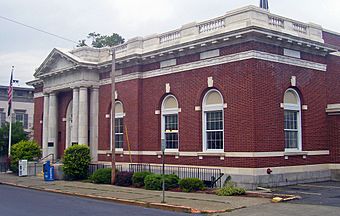United States Post Office (Hudson, New York) facts for kids
Quick facts for kids |
|
|
U.S. Post Office
|
|
|
U.S. Historic district
Contributing property |
|

South elevation and partial east profile, 2008
|
|
| Location | Hudson, NY |
|---|---|
| Built | 1911 |
| Architect | James Knox Taylor |
| Architectural style | Classical Revival, Colonial Revival |
| Part of | Hudson Historic District |
| MPS | U.S. Post Offices in New York State, 1858–1943, TR |
| NRHP reference No. | 88002508 |
| Added to NRHP | 1988 |
The U.S. Post Office in Hudson, New York, is an important building. It is located on Union Street, right across from the Columbia County courthouse. This post office handles mail for the area with ZIP Code 12534. This includes the city of Hudson and parts of the nearby Town of Greenport.
The building was constructed between 1909 and 1911. It mixes two old building styles: Colonial Revival and Classical Revival. The front part, called a portico, looks like the older courthouse across the street. In the 1930s, the post office was made bigger. New art was also added inside. This building is part of the Hudson Historic District, which was created in 1985. In 1988, the post office was added to the National Register of Historic Places. It is the only post office in Columbia County on this special list.
Contents
What the Post Office Looks Like
Outside the Building
The post office is a one-story building made of brick. It has a strong foundation made of granite. The roof is low and sloped, called a hipped roof. The windows are arched and decorated with white marble.
On the west side, facing South Fourth Street, there is a central section with five parts. The main door has fancy wooden pillars on each side. These pillars hold up a decorative piece called an entablature. It has a smooth band that says "Hudson, N.Y., 12534." The whole entrance is framed by a large arch with carved marble. Above this, there is a decorative railing called a balustraded parapet.
The south side of the building has a small porch-like area called a portico. It has two Doric columns that hold up a triangular top part, called a pediment. The entrance here is similar to the main one. Steps made of granite lead up from the street.
Inside the Lobby
The lobby inside is shaped like an "L." You can enter it from both the south and west sides. If you come in from the south, you enter a wooden hallway. This leads to a space with shiny terrazzo floors. These floors have white marble borders. The lower part of the walls, called wainscoting, is also marble.
The ceiling is high, and the plaster walls have decorative wooden pillars. These pillars have fancy tops called capitals. Above them is a decorative border. Above the door to the postmaster's office, there is a special cast stone relief sculpture. It is called "The History of Transportation."
The east part of the lobby is simpler. Its entrance also has a similar look to the outside. The bronze tables where customers stand are still the original ones.
History of the Hudson Post Office
Early Mail Service in Hudson
When Hudson became a city in 1785, mail was handled in a nearby town called Claverack. This was because Claverack was the main town for the county back then. Hudson got its own post office in 1793. It was first run out of a store on Warren Street. Later, it moved to another store on the same street.
Building the New Post Office
The old post office building was still in use in 1906. That year, the government set aside $75,000 to build a new post office. They wanted it to be across from the new courthouse and near other public buildings. Two years later, the land for the new building was bought for $15,000.
James Knox Taylor designed the building. He was the main architect for the Treasury Department. He designed many post offices in New York. He started adding classical and Renaissance styles to post office designs. He wanted the buildings to show the democratic ideas of the country's Founders. For the Hudson post office, he used two classical-style porches on a brick building that was mostly Colonial Revival. These porches looked similar to the courthouse across the street.
The building was supposed to be finished by August 1910. But it took longer and was not done until December 1911. The final cost was $58,576.
Changes Over Time
In the early 1930s, the post office needed to be bigger because Hudson was growing. More land was bought, and a house on it was torn down. The expansion was finished in 1938 and cost $99,000. During this work, the "Evolution of Transportation" sculpture by Vincent Glinsky was added to the lobby. This art was part of a government program called the Treasury Relief Art Project.
During this construction, some original windows were covered with bricks. The bronze handrail on the outdoor steps was also added then. In 1963, the outdoor steps were replaced, and the old lampposts were removed. Since then, the building has not had any major changes.

